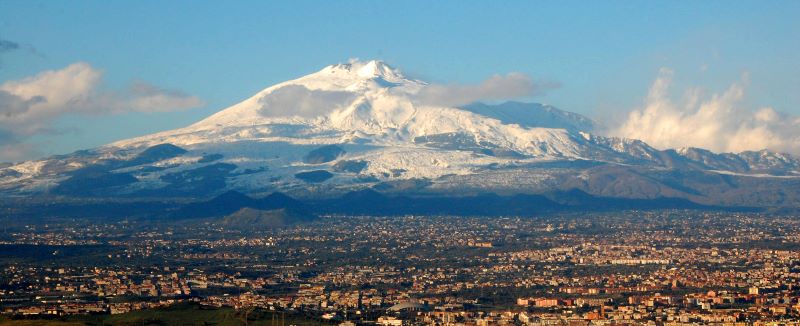
“The volcano is a she; the locals know, and that is how we refer to her. La Montagna.” Our guide through the vineyard on a northern slope of Mount Etna casts his eyes across the land. This particular business owns four hectares that are host to volcanic enriched soil, and is one of many wine producers in the region.
My family and I spent the better part of June traveling around Italy. Our journey took us to Sicily, the ancestral home of my family of origin, as well as my husband’s, where the espresso is as fluffy as the soil.
It is appropriate to classify Etna as a feminine noun; after all, it is women who usher new life into the world. Ask any child why they are fascinated by volcanoes, and they might tell you it is the power but also mystery inside each conical mass that makes for good storytelling. Ask an adult and they might suggest it is its paradoxical character that is so mesmerizing; for a volcano isn’t exclusively destructive. It is a force of creation as well, like Lord Shiva on fire.
This is one of the reasons people continue to live and farm near volcanoes, where every day must bring an element of danger and uncertainty. After any initial destruction caused by lava flows and heavy ash fall, the soil becomes resplendent. Over time, and with weathering, volcanic ash releases nutrient abundant minerals into the surrounding earth. Ash also has the property of being able to hold more water than say sand, contributing to land that is perfect for cultivation. The region Etna inhabits has been cultivated since before the birth of Christ, and is planted with vines, vegetables, and flowers.

While enjoying a wine flight, I could taste the gunpowder finish in a glass of Sicilian white, proving that the volcano really does make its way into the food chain. The energy output of a volcano enriches the soil, which in turn gives us nourishing food, which in turn gives us stores of energy.
I listened intently as the vintner explained the cycle. It is more than that, though, I kept thinking. As a Reiki master, I am keenly aware of the energy of all living things, and the energy that connects us all at a greater level. Not bound by religious tenets, those who practice Reiki and other forms of energy healing generally speak of a divine force that created all that is.
Standing in the shadow of Etna, it is easy to draw a parallel; the mountain fosters a mothering spark. It spews lava to supplement the soil, nurturing plants and even sea life, while simultaneously energizing an entire geographic area. Just being in its presence I felt time stand still and quicken in the same moment; I marveled at the irony of the stillness I felt in the presence of a rumbling giant, and I felt more alive and more present than before. I experienced what others have described as an energy vortex. Vortices are thought to be centers of concentrated energy here on Earth, conducive to healing and meditation. They are based on unseen energetic lines called leylines, similar to the meridians in Traditional Chinese Medicine, that crisscross the planet and intersect at certain points. The location of many sacred sites is thought to be along these lines.
After the wine tasting we met up with Salvatore, who gave us a tour of his family’s homestead by way of donkeys. The animals were well tended and loved, and we were simply along for the ride as they stopped to graze on wild fennel and amazingly sweet berries unique to that part of Italy.
Salvo, as he prefers to be called, starts each excursion with an important ritual: participants were asked to lay a hand on their donkey’s neck, taking an intentional moment to honor the burro’s spirit. Then, we mounted up and joined hands. We closed our eyes and listened to the breeze, to the land, to our own heartbeats. It was a way to get still and receive all that Etna – looming in the background—had to offer. Ecotourism at its best reminds you that we are all one, and our connection to the planet needs to be attended to and not forgotten.
With records dating back to 425 BC, Mount Etna’s history of eruptions is well documented. Following a four-year dormancy, it sprang to life July 2, 2024, just days after my family and I departed Sicily. The Italian island off the mainland hosts the stratovolcano on its eastern coast. Also known as a composite volcano, the mountain has been built up over time by layers of lava, rock, and ash, and today has many vents that reach the surface. It stands more than 10,000 feet high and is Europe’s tallest and most active volcano, sitting atop the convergent plate where the African and Eurasian plates meet.
As I heard the news of the recent eruption, I was unpacking my shoes, banging out dirt and debris from their soles. I thought about how those shoes surely picked up bits of sand and soil in Sicily; I had left one mountain behind, but was now dusting that mountain onto another. I also ruminated on the similarities between Etna and the Santa Monica Mountains as far as topography, landscape, proximity to the sea, foliage, and even lizards. The pace of life—or at least the desired pace—is a slower one, where residents get their hands dirty in service of the land, and in an effort to connect more deeply with mother nature.
I had gone to Sicily to honor my forebears and trace the path of those who came before me, and I found not only my start, but perhaps the start of everything.
IG DonnaFugataWine, IG EtnaDonkeyTrekking





